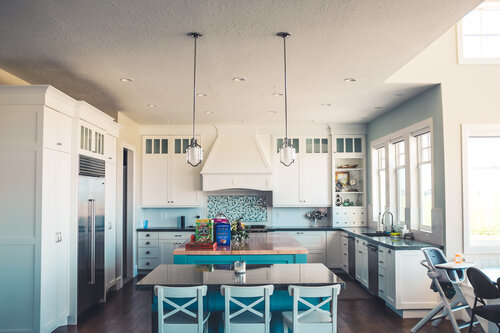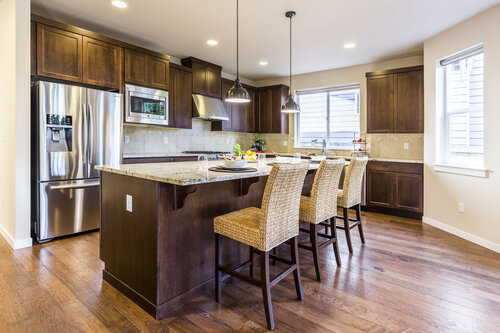 Wondering whether to go for natural wood or a painted finish for your cabinets? These observations can help
Wondering whether to go for natural wood or a painted finish for your cabinets? These observations can help
Kitchen cabinets are largely about the finish. Whether you’re buying cabinets for the first time or you’re a seasoned kitchen remodeler, it probably didn’t take you long to realize that stain and paint are two totally different slices of pie. Not sure which one you prefer? Here’s the scoop on the perks and pitfalls of both finishes.
Painted Cabinets
Pro: Paint Offers a Clean Aesthetic
Not all roads lead to a crisp kitchen design, but painted cabinetry is one that does. The classic all-white kitchen, for example, wouldn’t be what it is without gleaming white cabinets. However, all paint colors — whites and creams to grays and blues — bring a sleek, clean finish to the table. Paint is perfect for homeowners who aren’t a fan of the character marks common to stained wood cabinets and instead prefer a smooth, flawless finish.
Pro: Paint Allows You to Get More Colorful
If you’re thinking of tranquil teal, submarine yellow or lipstick red for your kitchen, look to painted cabinets. Paint sticks to the surface of wood, so it doesn’t get lost in the mix of grains and knots the way a stain does. As a result, paint showcases whichever hue you select and gives you more opportunity to customize the look of your kitchen.
Pro: Paint Applies Better to MDF
Choosing medium-density fiberboard (think particle or furniture board) is an effective way to cut cabinet costs. The material also takes paint well. Whether it’s a gray, white or cream color, it’s nearly impossible to tell the difference between these materials and real wood when they’re painted.
Con: Paint Hides Character Features
Paint is thicker than stain, so it doesn’t get absorbed by wood the way stain does. If you want to see grains and knots in plain sight, you probably shouldn’t go with painted cabinets. Though you’ll still see the grain imprints in woods like oak and hickory, they’ll mostly be hidden behind whichever coat of paint you choose. Some homeowners may see this characteristic as a plus (those who want clean and modern cabinetry, for instance). But those who are fond of wood’s natural beauty will chalk this down as a negative.
Con: Paint Tends to Cost More Painted cabinets aren’t exactly budget-friendly. They can be, but if you’re comparing them with stained cabinets, you’ll find that they often carry a steeper price tag. How much higher? The answer ultimately depends on who’s making the cabinets and where you’re buying them from, but typically they cost about 10% to 15% more. That’s hundreds or thousands of extra dollars you’re forking over, depending on the size of your kitchen.
Painted cabinets aren’t exactly budget-friendly. They can be, but if you’re comparing them with stained cabinets, you’ll find that they often carry a steeper price tag. How much higher? The answer ultimately depends on who’s making the cabinets and where you’re buying them from, but typically they cost about 10% to 15% more. That’s hundreds or thousands of extra dollars you’re forking over, depending on the size of your kitchen.
Con: Paint is Harder to Touch Up
This one may stir up a bit of debate among designers and homeowners. Paint touch-ups can be tricky. For one thing, you may not always know the exact color of your cabinet. If you’re buying semicustom or prefabricated cabinets, paint companies like Sherwin-Williams and Benjamin Moore may not have an exact match. Cabinetmakers and manufacturers may also apply paints by spraying, a method that looks smoother but is hard to replicate with a touch-up kit. Brushed finishes are better for hiding touch-ups.
Stained Cabinets
Pro: Stain Showcases More Wood Features
Stain strikes a good balance between color and texture. This is a definitive plus for many homeowners. Unlike paint, stain doesn’t steal the spotlight from your wood’s natural character. Since it’s thinner than paint, it seeps into the surface, which can enhance the natural beauty of your wood. You’ll definitely be able to admire the wood’s distinctive features.
 Pro: Stain is Easier to Touch Up
Pro: Stain is Easier to Touch Up
Touch-up markers for stains are easier to find, and even if there isn’t an exact match, there’s likely a color out there that closely resembles your stain. Touch-ups also tend to blend better on stained cabinets, especially ones with a lot of grain.
Pro: Stain Usually Costs Less
Cost ultimately hinges on several factors, like kitchen size, cabinet construction, manufacturer and so forth. But stain tends to keep costs on the lower side, a huge benefit if you’re flipping a house, remodeling a rental unit or simply don’t want to spend a fortune on kitchen cabinets. It generally costs less than paint, though customized options will be more expensive.
Con: Stain Shows Nearly All of Wood’s Blemishes
Some say blemishes; others say character. Again, some homeowners see this as nothing but a good thing. On the flip side, many don’t want to see wood’s imperfections, such as uneven grain distributions and color inconsistencies. Stains take a back seat to the wood they’re applied to, which allows every distinct feature to show — for better or worse.
Con: Stain Doesn’t Look as Good on MDF
Medium-density fiberboard can offer huge savings on cabinets, but it simply doesn’t take stain as well as it takes paint. Whereas paint rarely looks different on MDF exteriors, stains do. It isn’t as authentic of a look as, say, the hickory cabinetry pictured here. You’ll have to seek other ways to lower your cabinet cost if you’re set on stained cabinetry.
Con: Dark Stains and Paints Don’t Hide Dust Well
This is a negative for both dark stains and dark paints. While lighter cabinets can chip and stain more easily, they do a good job at hiding dust. Darker stains and paints, not so much. Dust particles stand out more on dark cabinet surfaces, which can require more upkeep.
Article written by: Sam FerrisJuly 9, 2020 for houzz.com
Images in order by: Obi Onyeador/Unsplash, NeONBRAND/Unsplash, Francesca Tosolini/Unsplash

Leave A Comment